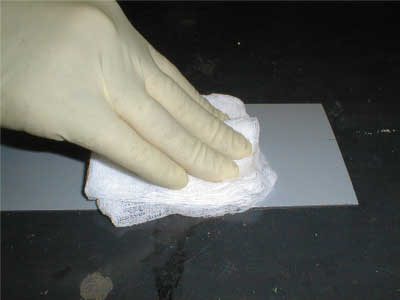Solvent Resistance Rub Test – ASTM D4752
Abrasion Testing
Accelerated Life Testing
Chemistry Laboratory
Computer Modeling
Salt Spray Testing
Density
Electrical Properties
Electron Microscopy
Experimental Foundry
Failure Analysis
Hardness Laboratory
Heat Treatment Studies
Light Microscopy
Lubrication Testing
Machine Shop
Materials Databases
Mechanical Testing
Metallography
Paint & Coatings
Product Testing
Rolling Mill
Thermal Testing
PAINT AND COATINGS LABORATORY
- Abrasion Testing
- Accelerated Life Testing
- Adhesion Testing
- Chemistry Analysis
- Corrosion Protection
- Failure Analysis
- Film Hardness Testing
- Film Thickness Measurement
- Formability Testing
- Gloss Measurement
- Heat Resistance Testing
- Solvent Testing
- Standard Applications Testing
- Impact Testing
- Volatiles – Total
- Volume Solid
Solvent Resistance Rub Test – ASTM D4752
 Evaluation for Solvent Resistance by Solvent Rub Test – ASTM D4752 and NCCA 11-18.
Evaluation for Solvent Resistance by Solvent Rub Test – ASTM D4752 and NCCA 11-18.
This test method is used to determine the degree of cure of a baked film by the paint film resistance to a specified solvent.
The Solvent Rub Test is usually performed using methyl ethyl ketone (MEK) as the solvent. The MEK resistance or degree of cure applies to paint topcoats and primers.
ASTM D4752 involves rubbing the surface of a baked film with cheesecloth soaked with MEK until failure or breakthrough of the film occurs. The type of cheesecloth, the stroke distance, the stroke rate, and approximate applied pressure of the rub are specified. The rubs are counted as a double rub (one rub forward and one rub backward constitutes a double rub).
The test is used widely in the paint industry because it provides a quick relative estimation of degree of cure without having to wait for long-term exposure results. It has been reported that the tests of two-componet zinc-rich primers has shown good correlation with the cure of the primer as determined by diffuse reflectance infrared spectroscopy.
Reference: ASTM D4752 Standard Test Method for Measuring MEK Resistance of Ethyl Silicate (Inorganic) Zinc-Rich Primers by Solvent Rub

